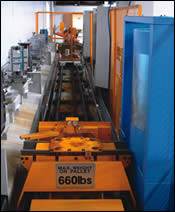The Responsiveness Robot
For this lean shop dedicated to low-inventory kanban relationships with customers, the most critical measure of efficiency revealed the value of robotic loading.
Share



Takumi USA
Featured Content
View More

Hwacheon Machinery America, Inc.
Featured Content
View More

Autodesk, Inc.
Featured Content
View More.png;maxWidth=45)
DMG MORI - Cincinnati
Featured Content
View More

ECi Software Solutions, Inc.
Featured Content
View MoreEnergy Dynamics could have bought a new lathe. It bought a robot instead.
The contract shop in Machesney Park, Illinois runs a family of parts for a hydraulic-power application on a lathe that is largely dedicated to this work. A faster lathe might have improved the efficiency of this operation. The shop did consider this, but it chose to keep the existing lathe—adding a robot. Though this robot was cheaper than the new machine tool would have been, price was not the reason. Rather, the choice came down to the way that this shop views “efficiency.”
Pat Bye, the shop’s president, points out that a faster lathe would merely have reduced machining cycle time. A multitasking lathe able to perform operations beyond just the turning would have done the same. That parameter, cycle time, is an obvious and important measure of productivity in many shops.
But Energy Dynamics is lean. The contract manufacturer is dedicated to kanban supply relationships with customers. A typical customer has no more than 5 days of parts in stock on Energy Dynamics’ shelves.
“We want to eliminate the need for large inventories. We even want to eliminate the need for production forecasts,” says Mr. Bye. “We want to work to the customer’s immediate demand, whatever that demand happens to be.”
As a result, the measure of efficiency for this shop is not cycle time but responsiveness—a parameter hat involves more than just time within the machine tool.
In fact, the concern that this shop gives to cycle time is rather small. Time within the machine is not the major bottleneck, because the shop does not run orders large enough for small cycle time differences to matter much. The major factor instead is how many setups per day the employees can perform. The robot helps with this measure of performance—and it does this in spite of the fact that robots typically are not seen as being consistent with lean.
Robots, instead, are seen as hard and heavy automation. The classic lean solutions, by contrast, are light, simple, straightforward and cheap. That is the perception, anyway.
But lean has to do with stripping away artificial barriers to getting the parts made, whatever those barriers are. The robot does this at Energy Dynamics by setting free a human being. Specifically, an operator gets free of loading and unloading parts to go set up another job somewhere else. Without the robot, the shop would not have been able to run this next job so quickly.
Going Lean
The name “Energy Dynamics” dates from the shop’s founding. Though it’s now a machining business and almost always has been, the company began with a business idea in the 1980s that never gelled. Providing machining services succeeded instead. Mr. Bye got the chance to build on that success when he bought the company in 2007.
He believed he could take the shop further by applying the lean manufacturing knowledge he had developed through a career in corporate production management. The shop was organized by equipment type when he found it, with a milling department, a turning department and so on. Mr. Bye led the re-arrangement of equipment into part-specific cells, allowing one operator to easily perform all the machining necessary for a part without having to batch the unfinished job in different areas of the shop. This change made it possible for inventory levels to change. Where the shop used to keep 3 months of inventory for each part number, the kanban quantity for most parts is now one week or less.
Various other long-standing aspects of the shop’s process had to change as well. To operate as an independent supplier with such low inventories, says Mr. Bye, the shop has to be able to set up and run new jobs without unpredictable delays. That meant material shipments, for example, also had to be driven by kanban requirements. The material supplier now is just as responsive as the shop, working to similarly small orders.
Yet the biggest changes of all were cultural. Habits and expectations had to change. An employee might still logically ask, “Why can’t I simply run a big set of parts ... since I already have the setup in place?”
The answer, of course, has to do with the investment that would be lost if the customer’s need for that part suddenly changed, or if some error in the first operation was not to be discovered until the whole batch had moved to the second operation. Mr. Bye says the only effective way to impart these kinds of lessons is to be alert for teachable moments. When the shop can fulfill an unexpected customer need because of the way it runs such small lots, he tries to make sure to point out this success to the employees involved. Over time, the impressions add up.
Customers have to be taught, too. Some are lean themselves, and they demand the kanban delivery. But others aren’t accustomed to the freedoms that lean manufacturing can provide. Just after one of the shop’s HMCs went to kanban, a customer altered the design of a part made on that machine. This customer expected to have to wait until the next run (potentially 3 months away) to implement the change. But Energy Dynamics was able to build and send the next week’s kanban set, per the new design, before the customer could even ship the old parts back to be modified.
Robot Logic
At the lathe, the robot now feeding work to the machine is a Fanuc Robotics LR Mate model 200iB with 5 kilograms of load capacity, installed by Gosiger Automation. As the photos in this article show, it sits compactly against the lathe. Mr. Bye says the shop routinely moves the robot out of the way in order to run jobs that don’t have use for the part handling.
The robot is actually just one example of an emphasis on employee availability that tends to drive equipment purchases now. The shop will favor an equipment purchase anytime that purchase can set employees free for more setups. Another example: If an operator has to set up any particular style of inserted tool more than three times per year, then the shop will buy a dedicated toolholder so that this tool body can remain in place.
Mr. Bye says the robot figures into one other important priority, too—preparing for the Baby Boomers to retire. As skilled personnel decline in numbers, he can imagine a day when the shop will make considerably greater use of less skilled employees. Robots will be one of the keys to doing this. Accordingly, he sees value in the shop getting accustomed to robots today.
Choosing the robot was obvious in light of these objectives. Even so, examining some of the alternatives that the shop might have chosen illustrates how the means to efficiency change when the part quantities are low.
For example, what about a bar feed? The shop could have chosen this accessory. With a bar feed, the work could be loaded as barstock, and the lathe could cut off discrete parts as it machines them.
Mr. Bye says the shop already has two bar feeds that it rarely uses. A bar feed locks the production run into a particular quantity—the number of pieces necessary to consume the bar.
Then what about a multitasking machine? The parts currently do not come off the lathe complete—they have to be passed to a machining center. Wouldn’t it be better to machine the parts complete in one setup?
In a way, yes, Mr. Bye says. However, without a robot, the machine would still be driven by the operator loading and unloading parts. The operator would still have to stand there.
By contrast, the robot lets the operator just queue raw stock and walk away, returning later to pick up completed parts in the unload queue that are ready for the VMC. And because turning and machining center work can occur simultaneously, overall throughput is better than what a single-setup process could achieve.
One final plus of using a robot is a benefit that Mr. Bye didn’t even think to anticipate—the boost to morale.
Robots aren’t common in contract shops, so contract shop employees don’t usually get to program and operate them. But the employees of Energy Dynamics now do, and employees have been enthusiastic to add and develop this skill. The result is not only improved capabilities for the shop, but also greater employee pride in their own abilities.
Related Content
The Future of High Feed Milling in Modern Manufacturing
Achieve higher metal removal rates and enhanced predictability with ISCAR’s advanced high-feed milling tools — optimized for today’s competitive global market.
Read MoreHow to Mitigate Chatter to Boost Machining Rates
There are usually better solutions to chatter than just reducing the feed rate. Through vibration analysis, the chatter problem can be solved, enabling much higher metal removal rates, better quality and longer tool life.
Read MoreInside the Premium Machine Shop Making Fasteners
AMPG can’t help but take risks — its management doesn’t know how to run machines. But these risks have enabled it to become a runaway success in its market.
Read MoreHow to Successfully Adopt Five-Axis Machining
While there are many changes to adopt when moving to five-axis, they all compliment the overall goal of better parts through less operations.
Read MoreRead Next
Cells To The Max
Brad Hart, president of Roberts Tool Company, in Chatsworth, California, believes that automated cells are the key to survival for companies likes his that machine complex, high-precision parts for aerospace and defense. Cellular manufacturing makes it possible to reduce lead times dramatically and minimize labor input while increasing throughput and improving quality, he says. In his shop, a cell consisting of two Toyoda HMCs and a dozen pallet stations epitomizes the lean manufacturing concepts that Mr. Hart finds so compelling. However, he says that shop owners have to get out of the business of making parts and into the business of building processes--processes such as those embodied in a lean manufacturing cell.
Read MoreRegistration Now Open for the Precision Machining Technology Show (PMTS) 2025
The precision machining industry’s premier event returns to Cleveland, OH, April 1-3.
Read MoreBuilding Out a Foundation for Student Machinists
Autodesk and Haas have teamed up to produce an introductory course for students that covers the basics of CAD, CAM and CNC while providing them with a portfolio part.
Read More


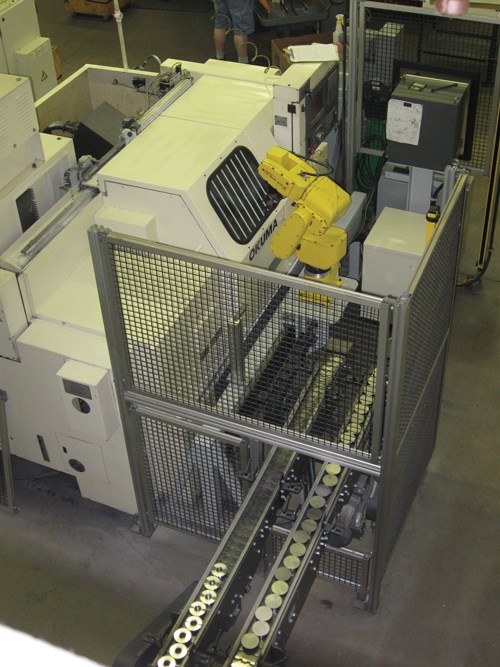
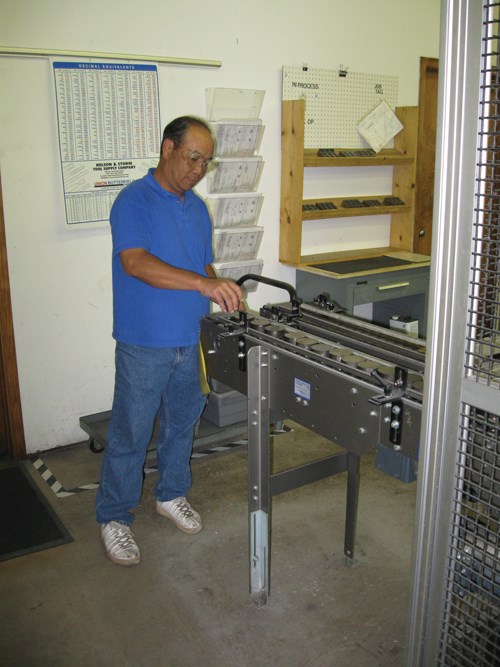
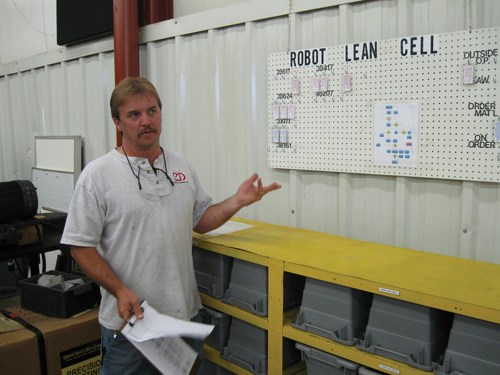
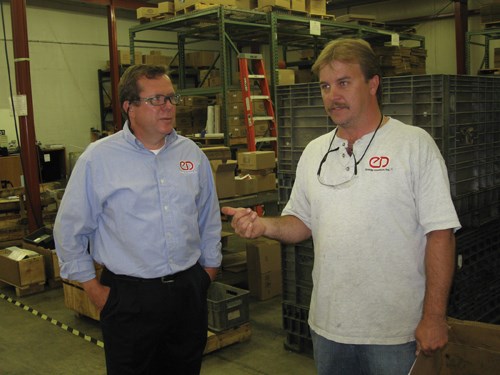
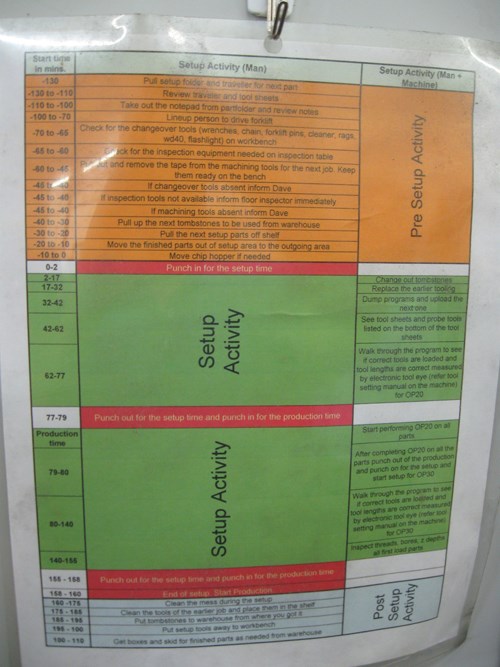





























.jpg;maxWidth=300;quality=90)
.jpg;maxWidth=300;quality=90)
















